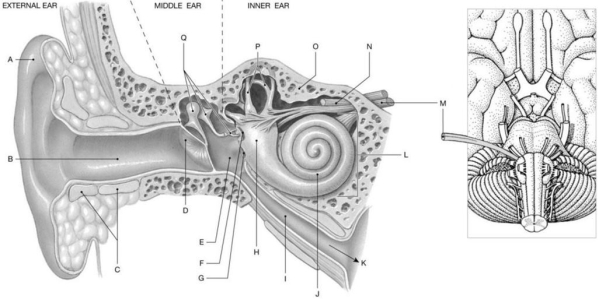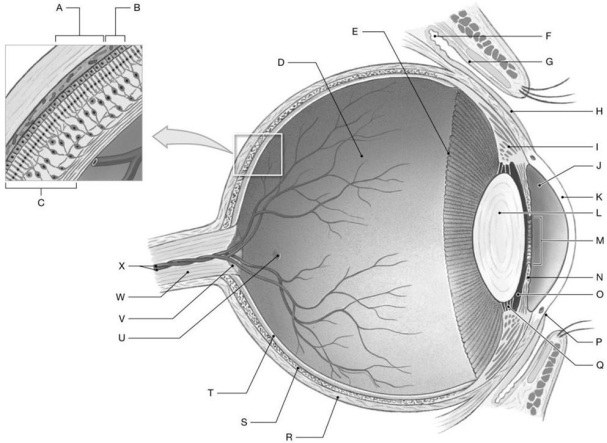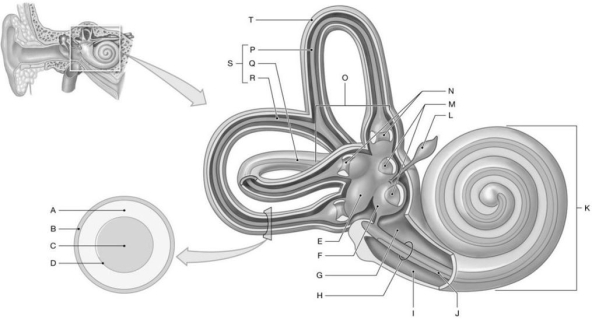A) It extends along the nasolacrimal canal formed by the lacrimal bone and the maxilla.
B) It sits within a depression in the frontal bone, within the orbit and superior and lateral to the eyeball.
C) It is located in the area of the medial canthus.
D) It is nestled within the ethmoid bone, medial to the superior orbital fissure.
E) It runs along grooves in the surface of the lacrimal bone.
Correct Answer

verified
Correct Answer
verified
Multiple Choice
The ciliary zonule of the lens is a ring of fibers that attaches the lens to which structure(s) ?
A) ora serrata
B) fovea
C) corneal limbus
D) ciliary processes
E) macula
Correct Answer

verified
Correct Answer
verified
True/False
The lacrimal gland secretions are viscous and slightly acidic.
Correct Answer

verified
Correct Answer
verified
Multiple Choice
Which of the following is the correct description of the tarsal plate?
A) It is a collective of skeletal muscles, which are responsible for closing the eyelids and raising the upper eyelid.
B) It is a collective of goblet cells within an epithelium that assists the various accessory glands in providing a superficial lubricant that prevents friction and drying of the opposing conjunctival surfaces.
C) It is a collection of layers of broad sheets of connective tissue, which support and strengthen the eyelids.
D) It is a mucous membrane covered by a specialized stratified squamous epithelium.
E) It is a thin layer of simple squamous epithelium that covers the visible surface of the eyelid.
Correct Answer

verified
Correct Answer
verified
Multiple Choice
Figure 18.1
 Using the figure above, identify the labeled structure(s) in each of the following questions.
-Identify the structure(s) indicated by Label H.
Using the figure above, identify the labeled structure(s) in each of the following questions.
-Identify the structure(s) indicated by Label H.
A) Semicircular canal
B) Tympanic cavity
C) Tympanic membrane
D) Vestibule
E) Auditory tube
Correct Answer

verified
Correct Answer
verified
Multiple Choice
Figure 18.3
 Using the figure above, identify the labeled structure(s) in each of the following questions.
-Identify the structure(s) indicated by Label O.
Using the figure above, identify the labeled structure(s) in each of the following questions.
-Identify the structure(s) indicated by Label O.
A) Posterior cavity
B) Anterior chamber (filled with aqueous humor)
C) Vestibule
D) Posterior chamber (filled with aqueous humor)
E) Ethmoidal labyrinth
Correct Answer

verified
Correct Answer
verified
Multiple Choice
Figure 18.3
 Using the figure above, identify the labeled structure(s) in each of the following questions.
-Identify the structure(s) indicated by Label W.
Using the figure above, identify the labeled structure(s) in each of the following questions.
-Identify the structure(s) indicated by Label W.
A) N V
B) N II
C) N IV
D) N I
E) N III
Correct Answer

verified
Correct Answer
verified
Multiple Choice
Which of the following is characteristic of the membranous labyrinth?
A) Its outer walls are fused with the surrounding temporal bone.
B) It is subdivided into the vestibule, the semicircular canals, and the cochlea.
C) Its fluid has a relatively low potassium ion concentration.
D) Its receptors provide sensations of gravity and linear acceleration.
E) It contains a fluid called endolymph.
Correct Answer

verified
Correct Answer
verified
True/False
Bulbous corpuscles are pressure and vibration receptors that adapt rapidly.
Correct Answer

verified
Correct Answer
verified
Multiple Choice
Oxygen and nutrients are delivered to the outer portion of the retina by an extensive capillary network contained within the ________.
A) sclera
B) macula
C) ora serrata
D) choroid
E) ciliary body
Correct Answer

verified
Correct Answer
verified
Multiple Choice
Figure 18.1
 Using the figure above, identify the labeled structure(s) in each of the following questions.
-Identify the structure indicated by Label K.
Using the figure above, identify the labeled structure(s) in each of the following questions.
-Identify the structure indicated by Label K.
A) External acoustic meatus
B) Auditory tube
C) Tympanic cavity
D) Vestibule
E) Cochlea
Correct Answer

verified
Correct Answer
verified
Multiple Choice
Figure 18.3
 Using the figure above, identify the labeled structure(s) in each of the following questions.
-Identify the structure(s) indicated by Label J.
Using the figure above, identify the labeled structure(s) in each of the following questions.
-Identify the structure(s) indicated by Label J.
A) Posterior chamber (filled with aqueous humor)
B) Cornea
C) Anterior chamber (filled with aqueous humor)
D) Ora serrata
E) Posterior cavity (vitreous chamber filled with the vitreous body)
Correct Answer

verified
Correct Answer
verified
Multiple Choice
Which is not a cell type found in the olfactory epithelium?
A) olfactory sensory neuron
B) supporting cell
C) basal epithelial cell
D) olfactory gland cell
E) All are found in the olfactory epithelium.
Correct Answer

verified
Correct Answer
verified
Multiple Choice
Which of the following is a structure of the fibrous layer?
A) iris
B) intrinsic eye muscles
C) sclera
D) ciliary body
E) choroid
Correct Answer

verified
Correct Answer
verified
Multiple Choice
Figure 18.2
 Using the figure above, identify the labeled structure(s) in each of the following questions.
-Identify the structure(s) indicated by Label D.
Using the figure above, identify the labeled structure(s) in each of the following questions.
-Identify the structure(s) indicated by Label D.
A) Vestibular duct
B) Bony labyrinth
C) Perilymph
D) Membranous labyrinth
E) Cochlear duct
Correct Answer

verified
Correct Answer
verified
Multiple Choice
Figure 18.2
 Using the figure above, identify the labeled structure(s) in each of the following questions.
-Identify the structure(s) indicated by Label H.
Using the figure above, identify the labeled structure(s) in each of the following questions.
-Identify the structure(s) indicated by Label H.
A) Semicircular duct
B) Tympanic duct
C) Cochlear duct
D) Auditory tube
E) Vestibular duct
Correct Answer

verified
Correct Answer
verified
Multiple Choice
Figure 18.3
 Using the figure above, identify the labeled structure(s) in each of the following questions.
-Identify the structure(s) indicated by Label L.
Using the figure above, identify the labeled structure(s) in each of the following questions.
-Identify the structure(s) indicated by Label L.
A) Pupil
B) Choroid
C) Lens
D) Conjunctiva
E) Cornea
Correct Answer

verified
Correct Answer
verified
Multiple Choice
In the eye, axons from ganglion cells converge on the ________.
A) optic disc
B) fovea
C) choroid
D) macula
E) vitreous body
Correct Answer

verified
Correct Answer
verified
Multiple Choice
Figure 18.3
 Using the figure above, identify the labeled structure(s) in each of the following questions.
-Identify the structure(s) indicated by Label C.
Using the figure above, identify the labeled structure(s) in each of the following questions.
-Identify the structure(s) indicated by Label C.
A) Conjunctiva
B) Vascular layer (choroid)
C) Retina
D) Ora serrata
E) Cornea
Correct Answer

verified
Correct Answer
verified
Multiple Choice
Figure 18.3
 Using the figure above, identify the labeled structure(s) in each of the following questions.
-Identify the structure(s) indicated by Label E.
Using the figure above, identify the labeled structure(s) in each of the following questions.
-Identify the structure(s) indicated by Label E.
A) Lateral canthus
B) Ciliary body
C) Sclera
D) Ora serrata
E) Choroid
Correct Answer

verified
Correct Answer
verified
Showing 61 - 80 of 127
Related Exams